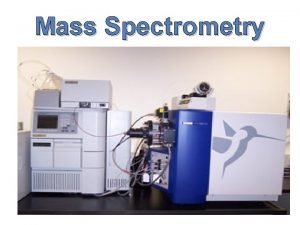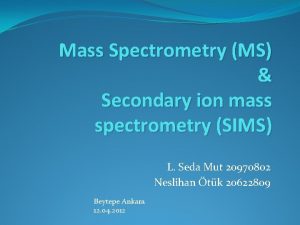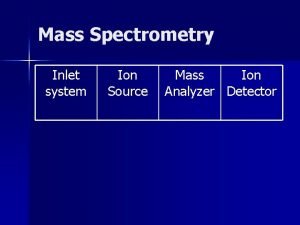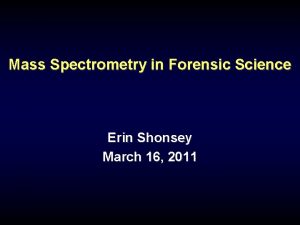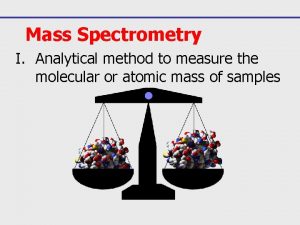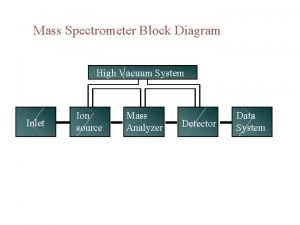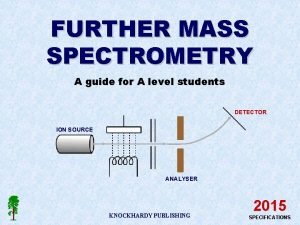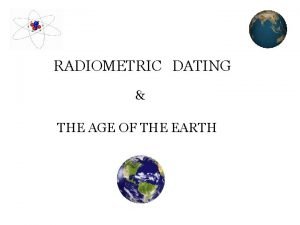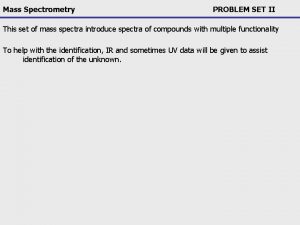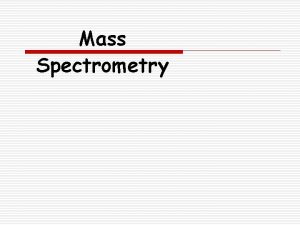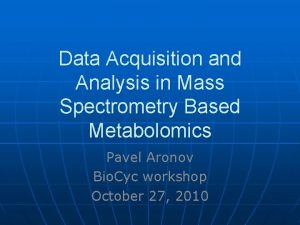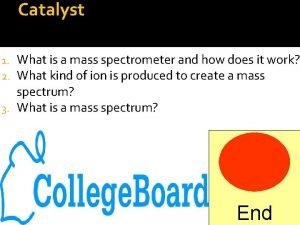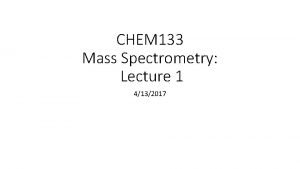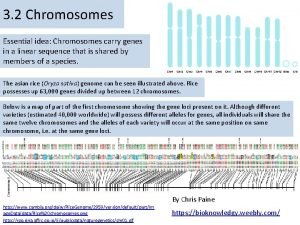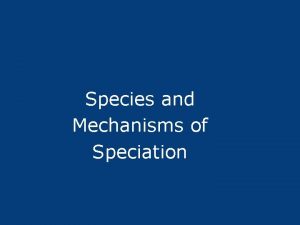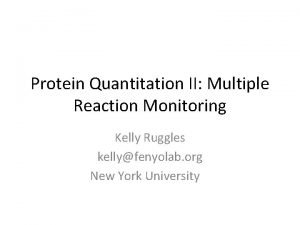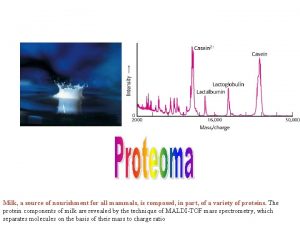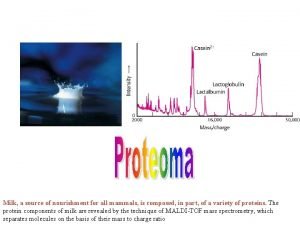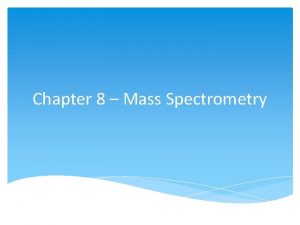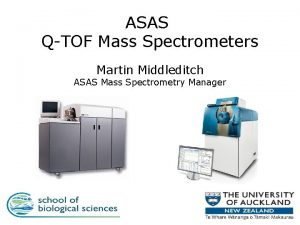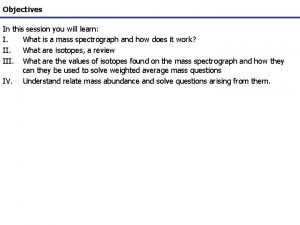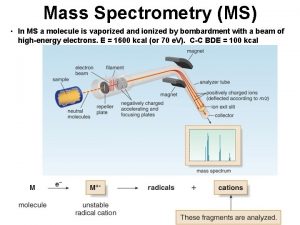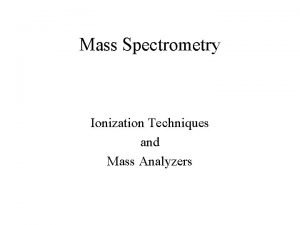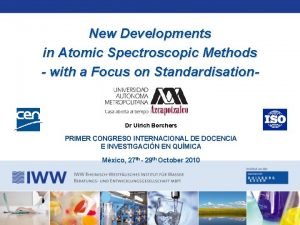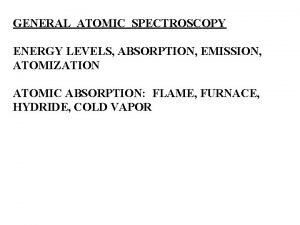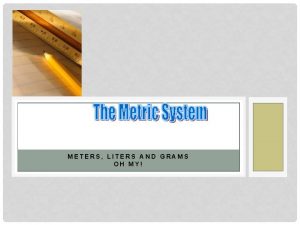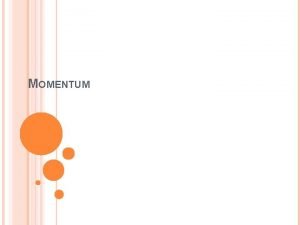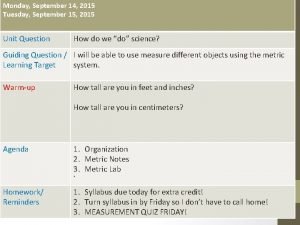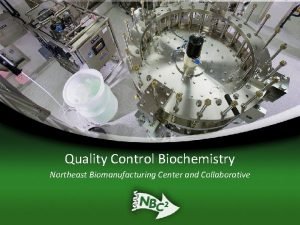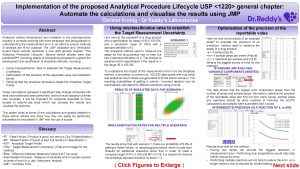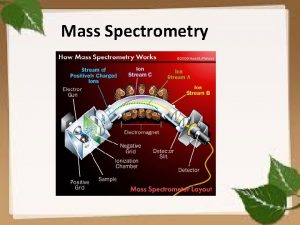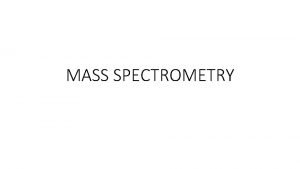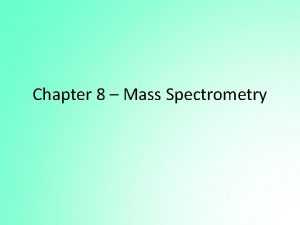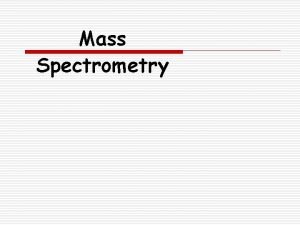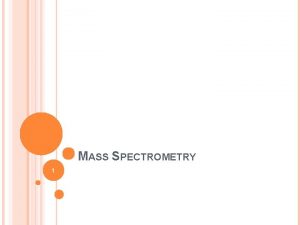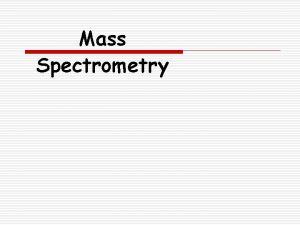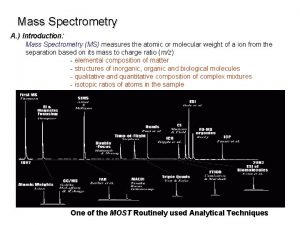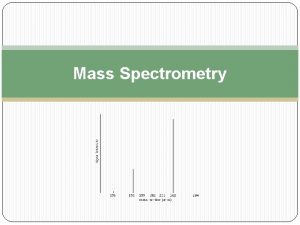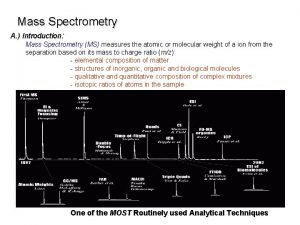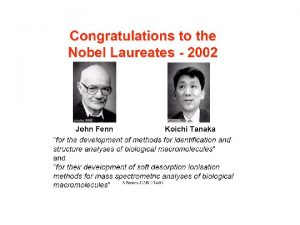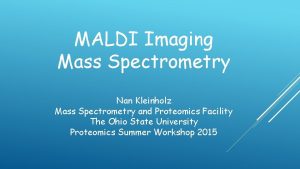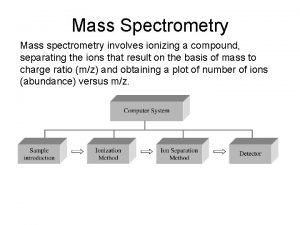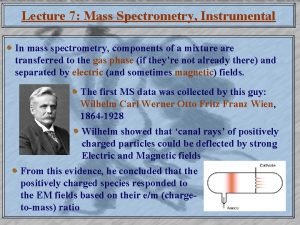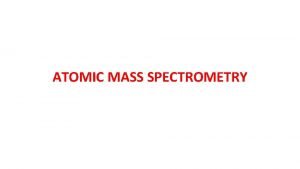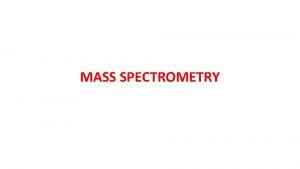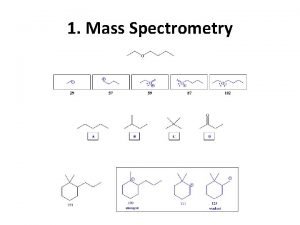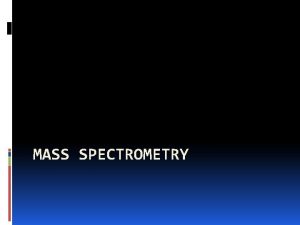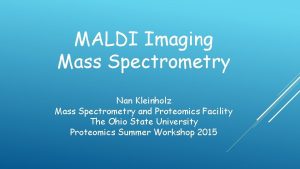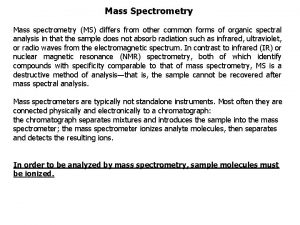Mass Spectrometry I Analytical method to measure the







































- Slides: 39

Mass Spectrometry I. Analytical method to measure the molecular or atomic mass of samples

MS Principles I. Different elements can be uniquely identified by their mass

MS Principles I. Different compounds can be uniquely identified by their mass Butorphanol L-dopa Ethanol N -CH 2 OH COOH HO -CH 2 CH-NH 2 CH 3 CH 2 OH HO HO MW = 327. 1 MW = 197. 2 MW = 46. 1

Mass Spectrometry I. For small organic molecules the MW can be determined to within 5 ppm or 0. 0005% which is sufficiently accurate to confirm the molecular formula from mass alone II. For large biomolecules the MW can be determined within an accuracy of 0. 01% (i. e. within 5 Da for a 50 k. D protein) III. Recall 1 dalton = 1 atomic mass unit (1 amu)

Mass Spectrometry I. Introduction A. General overview 1. Mass Spectrometry is the generation, separation and characterization of gas phase ions according to their relative mass as a function of charge 2. Previously, the requirement was that the sample be able to be vaporized (similar limitation to GC), but modern ionization techniques allow the study of such non-volatile molecules as proteins and nucleotides 3. The technique is a powerful qualitative and quantitative tool, routine analyses are performed down to the femtogram (10 -15 g) level and as low as the zeptomole (10 -21 mol) level for proteins 4. Of all the organic spectroscopic techniques, it is used by more divergent fields – metallurgy, molecular biology, semiconductors, geology, archaeology than any other

Mass Spectrometry II. The Mass Spectrometer A. General Schematic 1. A mass spectrometer needs to perform three functions: • Creation of ions – the sample molecules are subjected to a high energy beam of electrons, converting some of them to ions • Separation of ions – as they are accelerated in an electric field, the ions are separated according to mass-to-charge ratio (m/z) • Detection of ions – as each separated population of ions is generated, the spectrometer needs to qualify and quantify them 2. The differences in mass spectrometer types are in the different means to carry out these three functions 3. Common to all is the need for very high vacuum (~ 10 -6 torr), while still allowing the introduction of the sample

Mass Spectrometry II. The Mass Spectrometer B. Single Focusing Mass Spectrometer 1. A small quantity of sample is injected and vaporized under high vacuum 2. The sample is then bombarded with electrons having 25 -80 e. V of energy 3. A valence electron is “punched” off of the molecule, and an ion is formed

Mass Spectrometry II. The Mass Spectrometer B. The Single Focusing Mass Spectrometer 4. Ions (+) are accelerated using a (-) anode towards the focusing magnet 5. At a given potential (1 – 10 k. V) each ion will have a kinetic energy: ½ mv 2 = e. V As the ions enter a magnetic field, their path is curved; the radius of the curvature is given by: r = mv e. H If the two equations are combined to factor out velocity: m/e = H 2 r 2 2 V

Mass Spectrometry II. The Mass Spectrometer B. Single Focusing Mass Spectrometer 6. At a given potential, only one mass would have the correct radius path to pass through the magnet towards the detector 7. “Incorrect” mass particles would strike the magnet

Background I. The cations that are formed are separated by magnetic deflection.

Mass Spectrometry II. The Mass Spectrometer B. Single Focusing Mass Spectrometer 8. By varying the applied potential difference that accelerates each ion, different masses can be discerned by the focusing magnet 9. The detector is basically a counter, that produces a current proportional to the number of ions that strike it 10. This data is sent to a computer interface for graphical analysis of the mass spectrum

Mass spectrometry is a very powerful method to analyse the structure of organic compounds, but suffers from 3 major limitations: Compounds cannot be characterised without clean samples This technique has not the ability to provide sensitive and selective analysis of complex mixture For big molecules like peptides spectra are very complex and very difficult to interpret

Lets talk about mass! I. Atomic mass of Carbon II. Atomic mass of Chlorine III. Atomic mass of Hydrogen

Lets talk about mass! I. Atomic mass of Carbon A. 12. 00000000000000 amu II. Atomic mass of Chlorine A. 35. 4527 amu III. Atomic mass of Hydrogen A. 1. 00794 amu 1 amu = 1 dalton (Da)

What about isotopes? I. Atomic mass of Carbon A. 12. 000 amu for 12 C but 13. 3355 for 13 C II. Atomic mass of Chlorine A. 34. 9688 amu for 35 Cl and 36. 9659 for III. Atomic mass of Hydrogen A. 1. 00794 amu for H and 2. 0141 for D! 37 Cl

Just for clarification I. Atomic mass II. amu, atomic mass units (uma? ? ) III. “Da” or Dalton. IV. k. D (kilo. Dalton for macromolecules) V. 1 amu = 1. 66056*10 -27 kg. VI. proton, mp = 1. 67265*10 -27 kg, VII. neutron, mn = 1. 67495*10 -27 kg.

Ways to define and calculate the mass of an atom, molecule or ion I. Average mass: calculated using the atomic weight, which is the weighted average of the atomic masses of the different isotopes of each element in the molecule. Often used in stoichiometric calculations. I. Nominal mass: calculated using the mass of the predominant isotopes of each element rounded to the nearest integer value that corresponds to the mass number. II. Monoisotopic mass: calculated using the extract mass of the most abundance isotope for each constituent element. Use monoisotopic mass if possible in MS

Differences between Masses C 20 H 42 Nominal: Monoisotopic: Average: C 100 H 202 (20 x 12) + (42 x 1) = 282 u (20 x 12) + (42 x 1. 007825) = 282. 33 (20 x 12. 011) + (42 x 1. 00794) = 282. 5535 (100 x 12) + (202 x 1) = 1402 u (100 x 12) + (202 x 1. 007825) = 1403. 5807 (100 x 12. 011)+(202 x 1. 00794) = 1404. 7039

Exact Masses of Some Common Elements and Their Isotopes: Element Symbol Exact Mass (u) Rel. Abundance % Hydrogen 1 H 1. 007825037 100. 0 Deuterium 2 H or D 2. 014101787 0. 015 Carbon 12 12 C 12. 00000 100. 0 Carbon 13 13 C 13. 003354 1. 11223 Nitrogen 14 14 N 14. 003074 100. 0 Nitrogen 15 15 N 15. 00011 0. 36734 Oxygen 16 16 O 15. 99491464 100. 0 Oxygen 17 17 O 16. 9991306 0. 03809 Oxygen 18 18 O 17. 99915939 0. 20048 Fluorine 19 F 18. 998405 100. 0 Sodium 23 Na 22. 9897697 100. 0 Silicon 28 28 Si 27. 9769284 92. 23 Silicon 29 29 Si 28. 9764964 5. 0634 Silicon 30 30 Si 29. 9737717 3. 3612 Phosphorus 31 P 30. 9737634 100. 0 Sulfur 32 32 S 31. 972074 100. 0 Sulfur 33 33 S 32. 9707 0. 78931 Sulfur 34 34 S 33. 96938 4. 43065 Sulfur 36 36 S 35. 96676 0. 02105 Chlorine 35 35 Cl 34. 968854 100. 0 Chlorine 37 37 Cl 36. 965896 31. 97836

(a) only one chlorine atom (b) only one bromine atom 1: 1 35 Cl: 75. 77 37 Cl: 24. 23 79 Br: 50. 69 81 Br: 49. 31 3: 4: 1 c) one chlorine and one bromine atom






Mass Spectrometry II. The Mass Spectrometer C. Double Focusing Mass Spectrometer 1. Resolution of mass is an important consideration for MS 2. Resolution is defined as R = M/DM, where M is the mass of the particle observed and DM is the difference in mass between M and the next higher particle that can be observed 3. Suppose you are observing the mass spectrum of a typical terpene (MW 136) and you would like to observe integer values of the fragments: For a large fragment: R = 136 / (135 – 136) = 136 For a smaller fragment: R = 31 / (32 – 31) = 31 Even a low resolution instrument can produce R values of ~2000! 4. If higher resolution is required, the crude separation of ions by a single focusing MS can be further separated by a double-focusing instrument

Mass Spectrometry II. The Mass Spectrometer C. Double Focusing Mass Spectrometer 4. Here, the beam of sorted ions from the focusing magnet are focused again by an electrostatic analyzer where the ions of identical mass are separated on the basis of differences in energy 5. The “cost” of increased resolution is that more ions are “lost” in the second focusing, so there is a decrease in sensitivity

Mass Spectrometry II. The Mass Spectrometer D. Quadrupole Mass Spectrometer 1. Four magnets, hyperbolic in cross section are arranged as shown; one pair has an applied direct current, the other an alternating current 2. Only a particular mass ion can “resonate” properly and reach the detector The advantage here is the compact size of the instrument – each rod is about the size of a ballpoint pen

Mass Spectrometry II. The Mass Spectrometer D. Quadrupole Mass Spectrometer 3. The compact size and speed of the quadrupole instruments lends them to be efficient and powerful detectors for gas chromatography (GC) 4. Since the compounds are already vaporized, only the carrier gas needs to be eliminated for the process to take place 5. The interface between the GC and MS is shown; a “roughing” pump is used to evacuate the interface Small He molecules are easily deflected from their flight path and are pulled off by the vacuum; the heavier ions, with greater momentum tend to remain at the center of the jet and are sent to the MS

Mass Spectrometry III. The Mass Spectrum A. Presentation of data 1. The mass spectrum is presented in terms of ion abundance vs. m/e ratio (mass) 2. The most abundant ion formed in ionization gives rise to the tallest peak on the mass spectrum – this is the base peak, m/e 43

Mass Spectrometry III. The Mass Spectrum A. Presentation of data 3. All other peak intensities are relative to the base peak as a percentage 4. If a molecule loses only one electron in the ionization process, a molecular ion is observed that gives its molecular weight – this is designated as M+ on the spectrum M+, m/e 114

Mass Spectrometry III. The Mass Spectrum A. Presentation of data 5. In most cases, when a molecule loses a valence electron, bonds are broken, or the ion formed quickly fragment to lower energy ions 6. The masses of charged ions are recorded as fragment ions by the spectrometer – neutral fragments are not recorded ! fragment ions

Mass Spectrometry III. The Mass Spectrum B. Determination of Molecular Mass 1. When a M+ peak is observed it gives the molecular mass – assuming that every atom is in its most abundant isotopic form 2. Remember that carbon is a mixture of 98. 9% (mass 13) and <0. 1% 14 C (mass 14) 3. We look at a periodic table and see the atomic weight of carbon as 12. 011 – an average molecular weight 4. The mass spectrometer, by its very nature would see a peak at mass 12 for atomic carbon and a M + 1 peak at 13 that would be 1. 1% as high - We will discuss the effects of this later… 12 C (mass 12), 1. 1% 13 C

Mass Spectrometry III. The Mass Spectrum B. Determination of Molecular Mass 5. Some molecules are highly fragile and M+ peaks are not observed – one method used to confirm the presence of a proper M+ peak is to lower the ionizing voltage – lower energy ions do not fragment as readily 6. Three facts must apply for a molecular ion peak: 1) The peak must correspond to the highest mass ion on the spectrum excluding the isotopic peaks 2) The ion must have an odd number of electrons – usually a radical cation 3) The ion must be able to form the other fragments on the spectrum by loss of logical neutral fragments

Mass Spectrometry III. The Mass Spectrum B. Determination of Molecular Mass 5. The Nitrogen Rule is another means of confirming the observance of a molecular ion peak 6. If a molecule contains an even number of nitrogen atoms (only “common” organic atom with an odd valence) or no nitrogen atoms the molecular ion will have an even mass value 7. If a molecule contains an odd number of nitrogen atoms, the molecular ion will have an odd mass value 8. If the molecule contains chlorine or bromine, each with two common isotopes, the determination of M+ can be made much easier, or much more complex as we will see

Molecular Formulas – What can be learned from them Remember and Review! The Rule of Thirteen – Molecular Formulas from Molecular Mass – Lecture 1 When a molecular mass, M+, is known, a base formula can be generated from the following equation: M = n + r 13 13 the base formula being: C n Hn + r For this formula, the HDI can be calculated from the following formula: HDI = ( n – r + 2 ) 2

Rule of 13 The rule of 13 will give you a molecular formula for the alkane (C and H) for a corresponding molecular weight. Some examples follow. a) Assume you have a molecular weight of 400. Divide 400 by 13 which gives you 30. 7692. Thirty is the number of carbon atoms. Mutiply the remainder (. 7692) times 13 to get 10. Add this number, 10, to the whole number, 30, to get the number of hydrogens, 40. So the molecular formula is C 30 H 40 which equals 400. b) Assume you have a compound that you think is caffeine. You do a mass spectrum and it gives you a molecular weight of 194. Dividing 194 by 13 gives you 14. 9231. Multiplying 0. 9231 by 13 gives you 12. Therefore, the molecular formula of the alkane is C 14 H 26. Caffeine has four nitrogen atoms and two oxygen atoms which equals 88. Subtract 6 carbons and 16 hydrogens to get 88. Therefore, the molecular formula for caffeine is C 8 H 10 N 4 O.

Molecular Formulas – What can be learned from them Remember and Review! The Rule of Thirteen The following table gives the carbon-hydrogen equivalents and change in HDI for elements also commonly found in organic compounds: Element added Subtrac t: D HDI (DU in text) Element added Subtract: D HDI (DU in text) C H 12 7 35 Cl C 2 H 11 3 H 12 C -7 79 Br C 6 H 7 -3 O CH 4 1 F CH 7 2 N CH 2 1/2 Si C 2 H 4 1 S C 2 H 8 2 P C 2 H 7 2 I C 9 H 19 0

Mass Spectrometry III. The Mass Spectrum C. High Resolution Mass Spectrometry 1. If sufficient resolution (R > 5000) exists, mass numbers can be recorded to precise values (6 to 8 significant figures) 2. From tables of combinations of formula masses with the natural isotopic weights of each element, it is often possible to find an exact molecular formula from HRMS Example: HRMS gives you a molecular ion of 98. 0372; from mass 98 data: C 3 H 6 N 4 C 4 H 4 NO 2 C 4 H 6 N 2 O C 4 H 8 N 3 C 5 H 6 O 2 C 5 H 8 NO C 5 H 10 N 2 C 7 H 14 98. 0594 98. 0242 98. 0480 98. 0719 98. 0368 gives us the exact formula 98. 0606 98. 0845 98. 1096
 Esi, apci 차이
Esi, apci 차이 Mass spectrometry
Mass spectrometry Components of mass spectrometer
Components of mass spectrometer Batch inlet system in mass spectrometry
Batch inlet system in mass spectrometry Mass spectrometry in forensic science
Mass spectrometry in forensic science Quadrupole mass analyzer
Quadrupole mass analyzer 4-heptanone
4-heptanone Mass spectrometry a level
Mass spectrometry a level Dating
Dating Mass spectrometry problem set
Mass spectrometry problem set Rule of thirteen mass spectrometry
Rule of thirteen mass spectrometry Mass spectrometry data acquisition for gc/ms
Mass spectrometry data acquisition for gc/ms Khan academy mass spectrometry
Khan academy mass spectrometry Mass spectrometry exam questions
Mass spectrometry exam questions Mass spectrometry lecture
Mass spectrometry lecture Chromosomes and alleles
Chromosomes and alleles Assortative
Assortative Swath mass spectrometry
Swath mass spectrometry Mass spectrometry
Mass spectrometry Mass spectrometry
Mass spectrometry Mass spectrometry
Mass spectrometry Mass spectrometry
Mass spectrometry Deflection in mass spectrometry
Deflection in mass spectrometry Mass spectrometry
Mass spectrometry Mass spectrometry ionization
Mass spectrometry ionization Gibbons jacobean city comedy download
Gibbons jacobean city comedy download Measure air temperature and measure air pressure
Measure air temperature and measure air pressure Cold vapor atomic fluorescence spectrometry
Cold vapor atomic fluorescence spectrometry Cold vapor atomic fluorescence spectrometry
Cold vapor atomic fluorescence spectrometry Ion mobility spectrometry
Ion mobility spectrometry Grams meters liters
Grams meters liters Measure of mass in motion
Measure of mass in motion What use to measure mass
What use to measure mass Analytical method validation
Analytical method validation Usp 1220
Usp 1220 What is symposium in education
What is symposium in education Stoichiometry ratio
Stoichiometry ratio What makes up the atomic mass
What makes up the atomic mass Relative atomic mass of beryllium
Relative atomic mass of beryllium Propane percentage composition of each element
Propane percentage composition of each element

